CXC Home | Search | Help | Image Use Policy | Latest Images | Privacy | Accessibility | Glossary | Q&A
Video Series: Visual Descriptions
Narrated audio files of the visual descriptions of recent Chandra images released.

1.- Holiday Collection
(Mon, 22 Dec 2025 )Chandra is sending out a holiday card with four new images of cosmic wonders. Each of the quartet of objects evokes the winter season or one of its celebratory days, either in its name or shape.
Visual Description Text
More


2.- Black Hole Fractions
(Thu, 11 Dec 2025 )A new study, analyzing over 1,600 galaxies observed with Chandra over two decades, suggests that smaller galaxies do not contain supermassive black holes nearly as often as larger galaxies do.
Visual Description Text
More


3.- X-ray Arithmetic
(Tue, 09 Dec 2025 )A new image-processing technique called "X-arithmetic" is allowing astronomers to analyze Chandra's X-ray data and identify features in the gas of galaxy clusters and groups like never before.
Visual Description Text
More


4.- RACS J0320-35
(Thu, 18 Sep 2025 )A black hole is growing at one of the fastest rates ever recorded. This discovery from NASA's Chandra X-ray Observatory may help explain how some black holes can reach enormous masses relatively quickly after the Big Bang.
Visual Description Text
More


5.- Cassiopeia A
(Thu, 28 Aug 2025 )The star that exploded to become the Cassiopeia A supernova remnant appears to have undergone a dramatic event right before its demise. New evidence from Chandra indicates that the star's interior was violently rearranged just hours before the explosion.
Visual Description Text
More


6.- MSH 15-52
(Wed, 20 Aug 2025 )In 2009, NASA's Chandra X-ray Observatory released a captivating image: a pulsar and its surrounding nebula that is shaped like a hand. Since then, astronomers have used Chandra and other telescopes to continue to observe this object.
Visual Description Text
More


7.- NGC 6099 HLX-1
(Thu, 24 Jul 2025 )NASA'S Hubble Space Telescope and NASA's Chandra X-ray Observatory have teamed up to identify a new possible example of a rare class of black holes.
Visual Description Text
More


8.- Cosmic Collection
(Wed, 23 Jul 2025 )A new eye-catching compilation of images is being released that features data from NASA's Chandra X-ray Observatory along with a host of other telescopes including Webb, Hubble, and more.
Visual Description Text
More

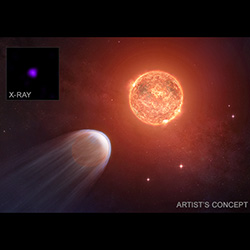
9.- TOI 1227 b
(Wed, 16 Jul 2025 )A baby planet is shrinking from the size of Jupiter with a thick atmosphere to a small, barren world, according to a new study from NASA's Chandra X-ray Observatory.
Visual Description Text
More


10.- Infinity Galaxy
(Tue, 15 Jul 2025 )Scientists have discovered an oddly-shaped galaxy that may contain the first newborn supermassive black hole ever spotted.
Visual Description Text
More

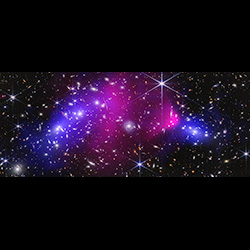
11.- Bullet Cluster
(Mon, 30 Jun 2025 )A new image of the iconic Bullet Cluster with Webb & Chandra data.
Visual Description Text
More


12.- M31
(Wed, 25 Jun 2025 )To celebrate the life and career of Dr. Vera Rubin, a new composite image of the Andromeda galaxy (M31) is being released.
Visual Description Text
More


13.- J1610+1811
(Mon, 09 Jun 2025 )A black hole has blasted out a surprisingly powerful jet in the distant universe. This jet exists early enough in the cosmos that it is being illuminated by the leftover glow from the big bang itself.
Visual Description Text
More


14.- PLCK G287.0+32.9
(Mon, 09 Jun 2025 )Astronomers have discovered the largest known cloud of energetic particles surrounding a galaxy cluster. The finding challenges long-standing theories about how particles stay energized over time.
Visual Description Text
More


15.- PSZ2 G181.06+48.47
(Wed, 04 Jun 2025 )New observations have captured a powerful cosmic event: two galaxy clusters have collided and are now poised to head back for another swipe at each other.
Visual Description Text
More


16.- ASKAP J1832-0911
(Wed, 28 May 2025 )Scientists have discovered a star behaving like no other seen before, giving new clues about the origin of a class of mysterious objects.
Visual Description Text
More


17.- Sonification Collection
(Thu, 08 May 2025 )This new trio of sonifications represents different aspects of black holes.
Visual Description Text
More


18.- AT2024tvd
(Thu, 08 May 2025 )Astronomers have discovered a black hole has torn apart a star in a surprising location.
Visual Description Text
More


19.- G359.13142-0.20005
(Thu, 01 May 2025 )Astronomers have discovered a likely explanation for a fracture in a huge cosmic "bone" in the Milky Way galaxy, using NASA's Chandra X-ray Observatory and radio telescopes.
Visual Description Text
More


20.- 3D Models
(Wed, 16 Apr 2025 )New three-dimensional (3D) models of objects in space have been released by NASA's Chandra X-ray Observatory. These 3D models allow people to explore – and print – examples of stars in the early and end stages of their lives.
Visual Description Text
More

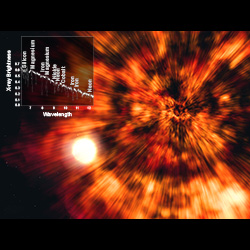
21.- GRO J1655-40
(Thu, 27 Mar 2025 )A team of astronomers has shown that they can use stars and the remains they leave behind to conduct a special kind of archaeology in space.
Visual Description Text
More


22.- Helix Nebula
(Tue, 04 Mar 2025 )After tracking a puzzling X-ray signal from a dying star for decades, astronomers may have finally explained its source: the old star might have destroyed a nearby planet.
Visual Description Text
More


23.- Tarantula Nebula
(Wed, 12 Feb 2025 )A bouquet of thousands of stars in bloom has arrived. This composite image contains the deepest X-ray image ever made of the spectacular star forming region called 30 Doradus.
Visual Description Text
More


24.- Filaments in Clusters
(Mon, 27 Jan 2025 )Astronomers have taken a crucial step in showing that the most massive black holes in the universe can create their own meals.
Visual Description Text
More


25.- Wolf 359
(Thu, 16 Jan 2025 )A new study examines the effects of X-ray and other high-energy radiation unleashed on potential exoplanets from a host star.
Visual Description Text
More


26.- Molecular Clouds in the Center of the Milky Way Galaxy
(Tue, 14 Jan 2025 )A creative new method uses decades of data to learn about the 3D structure of molecular clouds, the birthplace of stars, in the center of the Milky Way.
Visual Description Text
More


27.- NGC 602
(Tue, 17 Dec 2024 )Since antiquity, wreaths have symbolized the cycle of life, death, and rebirth. It is fitting then that one of the best places for astronomers to learn more about the stellar lifecycle resembles a giant holiday wreath itself.
Visual Description Text
More


28.- Centaurus A Knots
(Tue, 10 Dec 2024 )Astronomers have found an unusual mark from a giant black hole's powerful jet striking an unidentified object in its path.
Visual Description Text
More


29.- Guitar Nebula
(Wed, 20 Nov 2024 )Normally found only in heavy metal bands or certain post-apocalyptic films, a "flame-throwing guitar" has now been spotted moving through space.
Visual Description Text
More


30.- LID-568
(Mon, 04 Nov 2024 )Observations from Chandra and JWST reveal a low-mass supermassive black hole that appears to be consuming matter at over 40 times the theoretical limit.
Visual Description Text
More


31.- Cygnus OB2
(Mon, 28 Oct 2024 )A team of astronomers used NASA's Chandra X-ray Observatory, in combination with ultraviolet, optical and infrared data, to show where some of the most treacherous places in a star cluster may be, where planets' chances to form are diminished.
Visual Description Text
More


32.- AT2019qiz
(Wed, 09 Oct 2024 )A massive black hole has torn apart one star and is now using that stellar wreckage to pummel another star or smaller black hole that used to be in the clear.
Visual Description Text
More


33.- Zwicky 8338
(Thu, 19 Sep 2024 )Astronomers using Chandra have found a galaxy cluster has two streams of superheated gas crossing one another. This result shows that crossing the streams may lead to the creation of new structure.
Visual Description Text
More


34.- Sonification Collection
(Mon, 26 Aug 2024 )Sonifications of three images have been released to mark the 25th anniversary of Chandra's "First Light" image.
Visual Description Text
More


35.- AT2018fyk
(Wed, 14 Aug 2024 )A team of researchers have made important headway in understanding how — and when — a supermassive black hole obtains and then consumes material.
Visual Description Text
More


36.- 25 Images for Chandra's 25th Anniversary
(Mon, 22 Jul 2024 )To celebrate the 25th anniversary of its launch, NASA's Chandra X-ray Observatory is releasing 25 never-before-seen views of a wide range of cosmic objects.
Visual Description Text
More


37.- Cosmic Road Trip
(Thu, 11 Jul 2024 )It's time to take a cosmic road trip using light as the highway and visit four stunning destinations across space.
Visual Description Text
More


38.- 3C 58
(Thu, 20 Jun 2024 )A new study using NASA's Chandra and ESA's XMM-Newton reveals that the interiors of neutron stars may contain a type of ultra-dense matter not found anywhere else in the Universe.
Visual Description Text
More

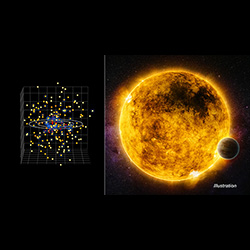
39.- Exoplanet Survey
(Wed, 12 Jun 2024 )This graphic shows a three-dimensional map of stars near the Sun that are close enough to Earth for planets in their habitable zones to be directly imaged using future telescopes.
Visual Description Text
More


40.- Supermassive Black Hole Survey
(Tue, 11 Jun 2024 )By combining forefront X-ray observations with state-of-the-art supercomputer simulations, researchers have provided the best modeling to date of the growth of the supermassive black holes found in the centers of galaxies.
Visual Description Text
More


41.- Westerlund 1
(Tue, 04 Jun 2024 )Westerlund 1 is the biggest and closest "super" star cluster to Earth. New data is helping astronomers delve deeper into this galactic factory where stars are vigorously being produced.
Visual Description Text
More


42.- Death Star Black Holes
(Wed, 22 May 2024 )Astronomers studied 16 supermassive black holes that are firing powerful beams, or jets, into space. They found that about a third of these have changed directions by large amounts.
Visual Description Text
More


43.- Galactic Center Vent
(Thu, 09 May 2024 )Eruptions from the supermassive black hole Sagittarius A* may have created an exhaust vent attached to a "chimney" of hot gas blowing away from the center of our Milky Way galaxy.
Visual Description Text
More


44.- Timelapse: Cassiopeia A & Crab Nebula
(Wed, 24 Apr 2024 )These two movies feature X-ray data collected by Chandra over about two decades of the Crab Nebula and Cassiopeia A.
Visual Description Text
More


45.- SNR 1181
(Wed, 27 Mar 2024 )In the year 1181 a rare supernova explosion appeared in the night sky, staying visible for 185 consecutive days. Now we can marvel at the same object that appeared in our ancestors' night sky more than 800 years ago.
Visual Description Text
More


46.- H1821+643
(Thu, 21 Mar 2024 )A brilliant supermassive black hole is not living up to expectations. Although it's responsible for high levels of radiation and powerful jets, this giant black hole is not as influential as many of its counterparts in other galaxies.
Visual Description Text
More


47.- Sonification Collection
(Wed, 28 Feb 2024 )Three new sonifications of images from NASA's Chandra X-ray Observatory and other telescopes have been released in conjunction with a new documentary about the project that makes its debut on the NASA+ streaming platform.
Visual Description Text
More


48.- Sagittarius A*
(Thu, 08 Feb 2024 )The supermassive black hole in the center of the Milky Way is spinning so quickly it is warping the spacetime surrounding it into a shape that looks like an American football.
Visual Description Text
More


49.- SS 433
(Wed, 17 Jan 2024 )This composite image of the Manatee Nebula captures the jet emanating from SS 433, a black hole pulling material inwards that is embedded in the supernova remnant which spawned it.
Visual Description Text
More


50.- Brightest Cluster Galaxies Survey
(Thu, 11 Jan 2024 )These four images represent a sample of galaxy clusters that are part of the largest and most complete study to learn what triggers stars to form in the universe's biggest galaxies.
Visual Description Text
More


51.- Cassiopeia A
(Mon, 08 Jan 2024 )Astronomers have combined data from NASA's Chandra X-ray Observatory and James Webb Space Telescope to study the well-known supernova remnant Cassiopeia A.
Visual Description Text
More


52.- 30 Doradus B
(Wed, 03 Jan 2024 )A colorful, festive image shows different types of light containing the remains of not one, but at least two, exploded stars.
Visual Description Text
More


53.- NGC 2264
(Tue, 19 Dec 2023 )This new image of NGC 2264, also known as the "Christmas Tree Cluster," shows the shape of a cosmic tree with the glow of stellar lights.
Visual Description Text
More


54.- Omega Centauri
(Thu, 30 Nov 2023 )A group of dead stars known as "spider pulsars" are obliterating companion stars within their reach.
Visual Description Text
More


55.- Galactic Center
(Wed, 15 Nov 2023 )A new collaboration is enabling actual data from NASA telescopes to be used as the basis for original music that humans can play.
Visual Description Text
More


56.- UHZ1
(Mon, 06 Nov 2023 )This image contains the most distant black hole ever detected in X-rays, a result that may explain how some of the first supermassive black holes in the universe formed.
Visual Description Text
More


57.- MSH 15-52
(Mon, 30 Oct 2023 )Chandra's data of MSH 15-52 have been combined with data from NASA's newest X-ray telescope, IXPE to unveil the magnetic field "bones" of this remarkable structure.
Visual Description Text
More


58.- SN 1006
(Thu, 26 Oct 2023 )Supernova 1006 was first seen in the sky on May 1, 1006 A.D. Today, scientists are learning even more about the spectacular stellar explosion documented in many parts of the world.
Visual Description Text
More


59.- Eta Carinae
(Tue, 26 Sep 2023 )A time-lapse sequence of Eta Carinae allows astronomers to watch as the stellar eruption continues to expand into space at speeds up to 4.5 million miles per hour.
Visual Description Text
More

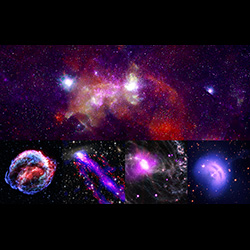
60.- Chandra Archive Collection
(Wed, 13 Sep 2023 )A new collection of stunning images highlights data from NASA's Chandra X-ray Observatory and other telescopes.
Visual Description Text
More


61.- ASASSN-14li
(Tue, 22 Aug 2023 )Astronomers using NASA's Chandra, ESA's XMM-Newton, and other telescopes have determined that a giant black hole has destroyed a large star and strewn its contents into space.
Visual Description Text
More


62.- El Gordo
(Wed, 02 Aug 2023 )New studies using NASA's Chandra X-ray Observatory & James Webb Space Telescope provide further insights into this hefty galaxy cluster.
Visual Description Text
More


63.- SPT-CL J2215-3537
(Thu, 20 Jul 2023 )Astronomers have discovered the most distant galaxy cluster with an important quality — paving the way to learning how and when some of these gigantic structures form and why the universe looks like it does in the present day.
Visual Description Text
More

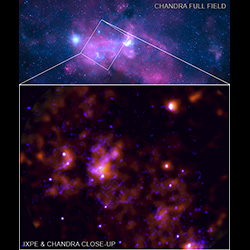
64.- Sagittarius A*
(Wed, 21 Jun 2023 )New data from IXPE has provided evidence that our Milky Way's supermassive black hole, Sagittarius A*, had an outburst about 200 years ago after devouring gas and dust within its reach.
Visual Description Text
More


65.- Sonification Collection
(Tue, 20 Jun 2023 )Sonification is a process that translates data into sounds and notes that humans can hear. Each layer of sound in these three new NASA sonifications represents particular wavelengths of light detected by Chandra, Webb, Hubble, and Spitzer in various combinations.
Visual Description Text
More


66.- NGC 4839
(Tue, 06 Jun 2023 )The NGC 4839 group of galaxies is plunging into the Coma galaxy cluster and leaving behind a tail of superheated gas.
Visual Description Text
More


67.- Chandra and Webb
(Tue, 23 May 2023 )4 composite images deliver dazzling views from NASA's Chandra X-ray Observatory and James Webb Space Telescope of two galaxies, a nebula, and a star cluster.
Visual Description Text
More


68.- M84
(Thu, 04 May 2023 )With a single letter seemingly etched in the X-ray glow around it, a giant black hole at the center of a massive elliptical galaxy is making a mark on its surroundings.
Visual Description Text
More


69.- Centaurus A
(Tue, 02 May 2023 )The galaxy Centaurus A shines bright in this image combining data from multiple observatories.
Visual Description Text
More


70.- Supernova Survey
(Thu, 20 Apr 2023 )Astronomers have identified a new threat to life on planets like Earth: a phase during which intense X-rays from exploded stars can affect planets over 100 light-years away.
Visual Description Text
More


71.- NGC 253
(Wed, 29 Mar 2023 )Data from Chandra show the effects of powerful winds launched from the center of a nearby galaxy.
Visual Description Text
More

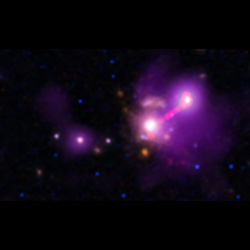
72.- 3C 297
(Wed, 08 Mar 2023 )A distant and lonely galaxy appears to have pulled in and assimilated all of its former companion galaxies.
Visual Description Text
More


73.- Tycho's Supernova Remnant
(Tue, 28 Feb 2023 )This image provides a new look at the Tycho supernova remnant, named for Danish astronomer Tycho Brahe who noticed the bright glow of this new "star" in the constellation Cassiopeia more than 450 years ago.
Visual Description Text
More


74.- Black Hole Pairs
(Wed, 22 Feb 2023 )A new study using NASA's Chandra X-ray Observatory has tracked two pairs of supermassive black holes in dwarf galaxies on collision courses.
Visual Description Text
More


75.- Abell 2256
(Mon, 30 Jan 2023 )Astronomers have captured a spectacular, ongoing collision between at least three galaxy clusters. Data from Chandra, XMM-Newton, and a trio of radio telescopes are helping astronomers sort out what is happening in this jumbled scene.
Visual Description Text
More


76.- XBONGS
(Wed, 11 Jan 2023 )A new survey using NASA's Chandra X-ray Observatory has uncovered hundreds of previously "hidden" black holes.
Visual Description Text
More


77.- Tarantula Nebula
(Mon, 09 Jan 2023 )The "Tarantula Nebula" (officially known as 30 Doradus) is available in a composite image of Chandra and JWST data for the first time.
Visual Description Text
More


78.- NGC 3293
(Thu, 15 Dec 2022 )This stellar cluster is one of 10 different systems that astronomers studied with Chandra to determine how magnetically active their stars are.
Visual Description Text
More


79.- RCW 36
(Tue, 29 Nov 2022 )A study of RCW 36 shows that stars in a cluster can limit how many new stars form when the biggest and brightest members expel most of the gas from the system, thus drastically slowing down star birth.
Visual Description Text
More


80.- V404 Cygni
(Mon, 21 Nov 2022 )A new sonification turns light echoes from a black hole into sound.
Visual Description Text
More


81.- Hot Jupiters
(Wed, 02 Nov 2022 )A new study using Chandra examines whether "hot Jupiter" exoplanets can have an anti-aging effect on the stars they orbit.
Visual Description Text
More


82.- Cassiopeia A
(Tue, 18 Oct 2022 )Astronomers have made the first measurement in X-rays of the polarization from the remains of an exploded star called Cassiopeia A.
Visual Description Text
More


83.- Abell 98
(Thu, 13 Oct 2022 )Astronomers taking inventory of the material in the local universe keep coming up short. A new result from NASA's Chandra X-ray Observatory about a system of colliding galaxy clusters may help explain this shortfall.
Visual Description Text
More


84.- Chandra and Webb
(Tue, 04 Oct 2022 )Images combining Webb infrared data with X-rays collected by Chandra underscore how the power of any of these telescopes is only enhanced when joined with others.
Visual Description Text
More

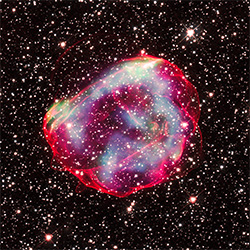
85.- SNR 0519-69.0
(Mon, 12 Sep 2022 )It is often difficult to determine the timeline of a star's demise. By studying the spectacular remains of a supernova, a team has found enough clues to help wind back the clock.
Visual Description Text
More


86.- NGC 4424
(Thu, 18 Aug 2022 )Astronomers may have witnessed a smaller galaxy colliding with a larger spiral galaxy and delivering a supermassive black hole.
Visual Description Text
More


87.- Zeta Ophiuchi
(Mon, 25 Jul 2022 )Zeta Ophiuchi is a star with a complicated past, having likely been ejected from its birthplace by a powerful stellar explosion. A new look by NASA's Chandra X-ray Observatory helps tell more of the story of this runaway star.
Visual Description Text
More


88.- G292.0+1.8
(Wed, 15 Jun 2022 )A young pulsar is blazing through the Milky Way at a speed of over a million miles per hour. This stellar speedster is one of the fastest objects of its kind ever seen.
Visual Description Text
More


89.- Abell 2146
(Tue, 07 Jun 2022 )A new study shows a deep connection between some of the largest, most energetic events in the Universe and much smaller, weaker ones powered by our own Sun.
Visual Description Text
More


90.- Sagittarius A*
(Thu, 12 May 2022 )As the Event Horizon Telescope was collecting data for its remarkable new image of the Milky Way's supermassive black hole, a legion of other telescopes, including Chandra, was also watching.
Visual Description Text
More


91.- Sonification Collection
(Wed, 04 May 2022 )Two new sonifications of well-known black holes have been released for NASA's Black Hole Week.
Visual Description Text
More


92.- Black Hole Survey
(Wed, 20 Apr 2022 )A new survey of over 100 galaxies by NASA's Chandra X-ray Observatory has uncovered signs that black holes are demolishing thousands of stars in a quest to pack on weight.
Visual Description Text
More


93.- Spiderweb Galaxy Field
(Thu, 31 Mar 2022 )Data from Chandra reveal feasting and growing black holes throughout the cosmic web that surrounds a central galaxy.
Visual Description Text
More


94.- PSR J2030+4415
(Mon, 14 Mar 2022 )A city-sized collapsed star has generated a beam of matter and antimatter that stretches for trillions of miles.
Visual Description Text
More


95.- GW170817
(Mon, 28 Feb 2022 )A neutron star merger that produced both gravitational waves and light.
Visual Description Text
More


96.- Chandra Archive Collection
(Wed, 02 Feb 2022 )A selection of multiwavelength images with Chandra data.
Visual Description Text
More


97.- Eta Carinae
(Tue, 25 Jan 2022 )A new astronomical visualization from NASA's Universe of Learning showcases the multiwavelength emissions and 3D structures surrounding Eta Carinae, one of the most massive and eruptive stars in our galaxy.
Visual Description Text
More


98.- Mrk 462
(Mon, 10 Jan 2022 )Chandra has detected X-rays from the dwarf galaxy Mrk 462, revealing the presence of a growing supermassive black hole.
Visual Description Text
More


99.- RBS 797
(Thu, 16 Dec 2021 )Scientists have found four enormous cavities, or bubbles, at the center of a galaxy cluster using NASA's Chandra X-ray Observatory.
Visual Description Text
More


100.- Planetary Nebula Archive
(Mon, 06 Dec 2021 )A collection of six planetary nebulas ranging from about 2,200 to 5,700 light years from Earth.
Visual Description Text
More

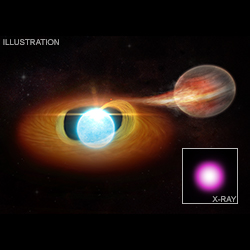
101.- KPD 0005+5106
(Mon, 22 Nov 2021 )New data suggest a white dwarf is blasting a companion object, either a low-mass star or planet, with waves of heat and radiation while pulling it apart through gravitational force.
Visual Description Text
More


102.- Whirlpool Galaxy
(Mon, 25 Oct 2021 )Astronomers have found evidence for a possible planet candidate in the M51 ("Whirlpool") galaxy, representing what could be the first planet detected outside of the Milky Way.
Visual Description Text
More


103.- G344.7-0.1
(Tue, 12 Oct 2021 )Studies of the elements left behind by explosions like this are some of the best tools available to scientists to better understand the details of Type Ia supernovas.
Visual Description Text
More


104.- Sonification Collection
(Thu, 16 Sep 2021 )A "sonification" project led by NASA's Chandra X-ray Observatory and the Universe of Learning transforms otherwise inaudible data from some of the world's most powerful telescopes into sound.
Visual Description Text
More


105.- MG B2016+112
(Tue, 31 Aug 2021 )By taking advantage of a natural lens in space, astronomers have captured an unprecedented look at X-rays from a black hole system in the early Universe.
Visual Description Text
More


106.- V404 Cygni
(Thu, 05 Aug 2021 )A spectacular set of rings around a black hole has been captured using NASA's Chandra X-ray Observatory and Neil Gehrels Swift Observatory.
Visual Description Text
More


107.- Abell 1775
(Thu, 15 Jul 2021 )Galaxy clusters are the titans of the Universe. A new study using NASA's Chandra X-ray Observatory examines the repercussions after two galaxy clusters clashed.
Visual Description Text
More


108.- Northern Clump
(Fri, 02 Jul 2021 )Researchers have found a galaxy cluster acting like a passenger on what astronomers are calling an "intergalactic highway."
Visual Description Text
More


109.- MSH 15-52
(Thu, 24 Jun 2021 )Motions of a remarkable cosmic structure have been measured for the first time, using NASA's Chandra X-ray Observatory.
Visual Description Text
More


110.- Super Flares
(Wed, 16 Jun 2021 )The largest survey ever of star-forming regions in X-rays outlines the link between very powerful flares and the impact they could have on planets in orbit around them.
Visual Description Text
More


111.- Galactic Center
(Thu, 27 May 2021 )A new panorama from NASA's Chandra X-ray Observatory and the MeerKAT radio telescope provides a stunning view of the center of our Milky Way galaxy.
Visual Description Text
More


112.- IC 443
(Thu, 20 May 2021 )Chandra's collection of 3D computer models and prints is now available on a new platform from the Smithsonian Institution. This will provide greater access to these resources for libraries, museums, scientists, and the public.
Visual Description Text
More


113.- Cassiopeia A
(Wed, 21 Apr 2021 )Astronomers have discovered an important type of titanium blasting out from the center of the supernova remnant Cassiopeia A, a result that could be a major advance in understanding how some massive stars explode.
Visual Description Text
More


114.- M87
(Wed, 14 Apr 2021 )In April 2019, scientists released the first image of a black hole in the galaxy M87 using the Event Horizon Telescope (EHT). However, that remarkable achievement was just the beginning of the science story to be told.
Visual Description Text
More


115.- Uranus
(Wed, 31 Mar 2021 )Astronomers have detected X-rays from Uranus for the first time, using NASA's Chandra X-ray Observatory.
Visual Description Text
More


116.- Sonification Collection
(Wed, 24 Mar 2021 )As part of our ongoing data sonification series, three new images have now been released.
Visual Description Text
More


117.- PJ352-15
(Tue, 09 Mar 2021 )Astronomers may have found the most distant supermassive black hole with a jet detected in X-rays using NASA's Chandra X-ray Observatory.
Visual Description Text
More


118.- Supernova 1987A
(Tue, 23 Feb 2021 )Astronomers have found evidence for the existence of a neutron star at the center of Supernova 1987A (SN 1987A), which scientists have been seeking for over three decades.
Visual Description Text
More


119.- Sagittarius A East
(Mon, 08 Feb 2021 )Astronomers have found evidence for an unusual type of supernova near the center of the Milky Way galaxy.
Visual Description Text
More

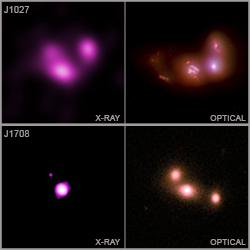
120.- Triple Galaxy Mergers
(Thu, 14 Jan 2021 )When three galaxies collide, what happens to the central black holes growing at the cores of each?
Visual Description Text
More


121.- J1818.0-1607
(Fri, 08 Jan 2021 )In 2020, astronomers added a new member to an exclusive family of exotic objects with the discovery of a magnetar. New Chandra observations help support the idea that it is also a pulsar.
Visual Description Text
More



